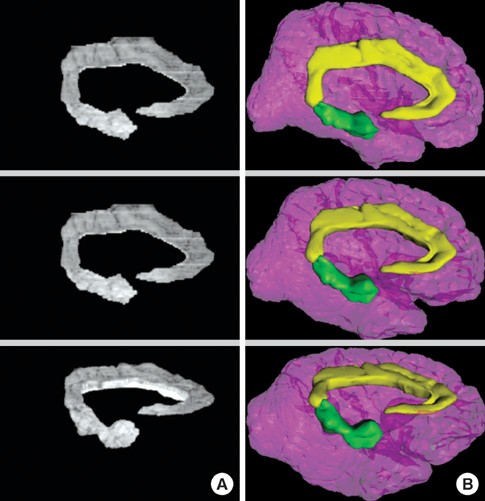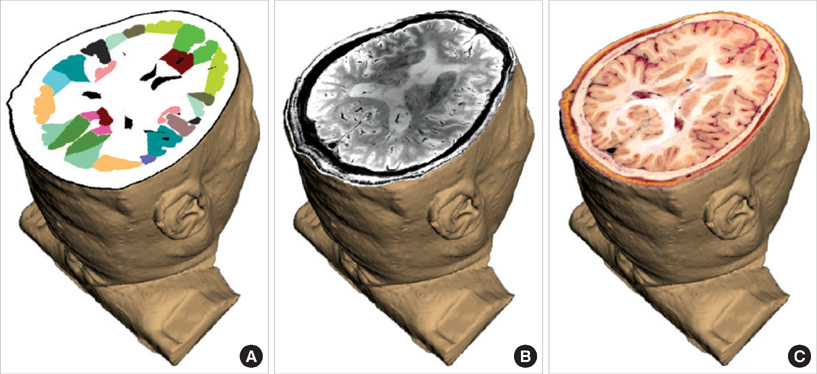J Korean Med Sci.
2010 Dec;25(12):1710-1715. 10.3346/jkms.2010.25.12.1710.
Segmentation of Cerebral Gyri in the Sectioned Images by Referring to Volume Model
- Affiliations
-
- 1Department of Anatomy, Dongguk University College of Medicine, Gyeongju, Korea.
- 2Department of Anatomy, Ajou University School of Medicine, Suwon, Korea. sds@ajou.ac.kr
- 3Department of Pathology, Seoul National University College of Medicine, Seoul, Korea.
- KMID: 1792892
- DOI: http://doi.org/10.3346/jkms.2010.25.12.1710
Abstract
- Authors had prepared the high-quality sectioned images of a cadaver head. For the delineation of each cerebral gyrus, three-dimensional model of the same brain was required. The purpose of this study was to develop the segmentation protocol of cerebral gyri by referring to the three-dimensional model on the personal computer. From the 114 sectioned images (intervals, 1 mm), a cerebral hemisphere was outlined. On MRIcro software, sectioned images including only the cerebral hemisphere were volume reconstructed. The volume model was rotated to capture the lateral, medial, superior, and inferior views of the cerebral hemisphere. On these four views, areas of 33 cerebral gyri were painted with colors. Derived from the painted views, the cerebral gyri in sectioned images were identified and outlined on the Photoshop to prepare segmented images. The segmented images were used for production of volume and surface models of the selected gyri. The segmentation method developed in this research is expected to be applied to other types of images, such as MRIs. Our results of the sectioned and segmented images of the cadaver brain, acquired in the present study, are hopefully utilized for medical learning tools of neuroanatomy.
Keyword
MeSH Terms
Figure
Cited by 1 articles
-
Dawn of the Visible Monkey: Segmentation of the Rhesus Monkey for 2D and 3D Applications
Chung Yoh Kim, Ae-Kyoung Lee, Hyung-Do Choi, Jin Seo Park
J Korean Med Sci. 2020;35(15):e100. doi: 10.3346/jkms.2020.35.e100.
Reference
-
1. Baron JC, Chételat G, Desgranges B, Perchey G, Landeau B, de la Sayette V, Eustache F. In vivo mapping of gray matter loss with voxel-based morphometry in mild Alzheimer's disease. Neuroimage. 2001. 14:298–309.
Article2. Teipel SJ, Alexander GE, Schapiro MB, Möller HJ, Rapoport SI, Hampel H. Age-related cortical grey matter reductions in non-demented Down's syndrome adults determined by MRI with voxel-based morphometry. Brain. 2004. 127:811–824.
Article3. Park JS, Chung MS, Shin DS, Har DH, Cho ZH, Kim YB, Han JY, Chi JG. Sectioned images of the cadaver head including the brain and correspondences with ultrahigh field 7.0 T MRIs. Proc IEEE. 2009. 97:1988–1996.4. Park JS, Chung MS, Park HS, Shin DS, Har DH, Cho ZH, Kim YB, Han JY, Chi JG. A proposal of new reference system for the standard axial, sagittal, coronal planes of brain based on the serially-sectioned images. J Korean Med Sci. 2010. 25:135–141.
Article5. Talairach J, Tournoux P. Co-planar Stereotaxic Atlas of the Human Brain: 3-Dimensional Proportional System: An Approach to Cerebral Imaging. 1988. Stuttgart: Thieme.6. Cho ZH. 7.0 Tesla MRI Brain Atlas: In Vivo Atlas With Cryomacrotome Correlation. 2009. New York, Dordrecht, Heidelberg, London: Springer.7. Federative Committee on Anatomical Terminology. Terminologia Anatomica: International Anatomical Terminology. 1998. Stuttgart, New York: Thieme.8. Kiernan JA. Barr's the Human Nervous System: An Anatomical Viewpoint. 2009. 9th Ed. Philadelphia, Baltimore, New York, London, Buenos Aires, Hong Kong, Sydney, Tokyo: Lippincott Williams & Wilkins;211–218.9. Park JS, Chung MS, Hwang SB, Lee YS, Har DH. Technical report on semiautomatic segmentation using the Adobe Photoshop. J Digit Imaging. 2005. 18:333–343.
Article10. Park JS, Shin DS, Chung MS, Hwang SB, Chung J. Technique of semiautomatic surface reconstruction of the Visible Korean Human data by using commercial software. Clin Anat. 2007. 20:871–879.11. Shin DS, Chung MS, Lee JW, Park JS, Chung J, Lee SB, Lee SH. Advanced surface reconstruction technique to build detailed surface models of liver and neighboring structures from the Visible Korean Human. J Korean Med Sci. 2009. 24:375–383.12. Shin DS, Park JS, Lee SB, Lee SH, Chung J, Chung MS. Surface model of the gastrointestinal tract constructed from the Visible Korean. Clin Anat. 2009. 22:601–609.
Article
- Full Text Links
- Actions
-
Cited
- CITED
-
- Close
- Share
- Similar articles
-
- Dawn of the Visible Monkey: Segmentation of the Rhesus Monkey for 2D and 3D Applications
- Serially Sectioned Images of the Whole Body (Eighth Report: Segmentation of the Upper Limb's Structures)
- Real-Color Volume Models Made from Real-Color Sectioned Images of Visible Korean
- Serially Sectioned and Segmented Images of the Mouse for Learning Mouse Anatomy
- Automated Techniques for the Sectioned Images of Visible Korean






